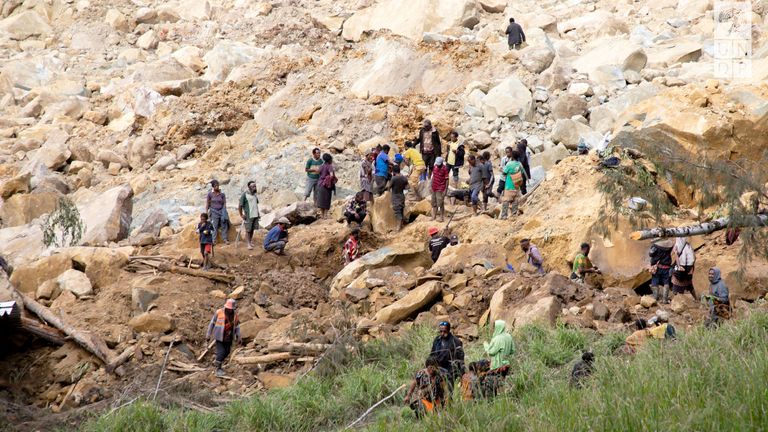Authorities fear a second landslide and a disease outbreak are looming at the scene of Papua New Guinea’s mass-casualty disaster because of water streams and bodies trapped beneath the tons of debris that swept over a village, a United Nations official said Tuesday.
A mass of boulders, earth and splintered trees devastated Yambali in the South Pacific nation’s remote highlands when a limestone mountainside sheared away Friday. The blanket of debris has become more unstable with recent rain and streams trapped between the ground and rubble, said Serhan Aktoprak, chief of the International Organization for Migration’s mission in Papua New Guinea.
The U.N. agency has officials at the scene in Enga province helping shelter 1,600 displaced people. The agency estimates 670 villagers died, while Papua New Guinea’s government has told the United Nations it thinks more than 2,000 people were buried. Six bodies had been retrieved from the rubble by Tuesday, a U.N. statement said.
“We are hearing suggestions that another landslide can happen and maybe 8,000 people need to be evacuated,” Aktoprak told The Associated Press.
“This is a major concern. The movement of the land, the debris, is causing a serious risk, and overall the total number of people that may be affected might be 6,000 or more,” he said. That includes villagers whose source of clean drinking water has been buried and subsistence farmers who lost their vegetable gardens.
“If this debris mass is not stopped, if it continues moving, it can gain speed and further wipe out other communities and villages further down” the mountain, Aktoprak said.
A U.N. statement later tallied the affected population at 7,849, including people who might need to be evacuated or relocated. The U.N. said 42% of those people were younger than 16 years old.
Scenes of villagers digging with their bare hands through muddy debris in search of their relatives’ remains were also concerning.
“My biggest fear at the moment is corpses are decaying, … water is flowing and this is going to poise serious health risks in relation to contagious diseases,” Aktoprak said.
Aktoprak’s agency was raising those concerns at a disaster management virtual meeting of national and international responders Tuesday.
The warning comes as geotechnical experts and heavy earth-moving equipment are expected to reach the site soon.
The Papua New Guinea government on Sunday officially asked the United Nations for additional help and to coordinate contributions from individual nations.
An Australian disaster response team arrived Tuesday in Papua New Guinea, which is Australia’s nearest neighbor. The team includes a geohazard assessment team and drones to help map the site.
“Their role will be particularly helping perform geotechnical surveillance to establish the level of the landslip, the instability of the land there, obviously doing some work around identifying where bodies are,” said Murray Watt, Australia’s minister for emergency management.
The Australian government has offered long-term logistical support for clearing debris, recovering bodies and supporting displaced people. The government announced an initial aid package of 2.5 million Australian dollars ($1.7 million).
Earth-moving equipment used by Papua New Guinea’s military was expected to arrive soon, after traveling from the city of Lae, 400 kilometers (250 miles) to the east, said Justine McMahon, country director of for humanitarian agency CARE International.
The landslide buried a 200-meter (650-foot) stretch of the province’s main highway. But the highway had been cleared from Yambali to the provincial capital Wabag through to Lae, officials said Tuesday from Enga.
“One of the complicating factors was the destruction of parts of the road plus the instability of the ground, but they have some confidence that they can take in heavy equipment today,” McMahon said Tuesday.
An excavator donated by a local builder Sunday became the first piece of heavy earth-moving machinery brought in to help villagers who have been digging with shovels and farming tools to find bodies.
Heartbroken and frustrated Yambali resident Evit Kambu thanked those who were trying to find her missing relatives in the rubble.
“I have 18 of my family members buried under the debris and soil that I’m standing on,” she told Australian Broadcasting Corp. through an interpreter.
“But I can’t retrieve the bodies, so I’m standing here helplessly,” she added.
Australian Deputy Prime Minister Richard Marles said an Australian air force C-17 Globemaster, a four-engine transport jet capable of carrying 77 metric tons (85 U.S. tons) of cargo, was already bringing supplies from Australia to Papua New Guinea’s capital, Port Moresby.
Two smaller Australian air force turboprop transport planes were already at Port Moresby, which is 600 kilometers (370 miles) southeast of the devastated village.
“There is more that we are seeking to do, but to be frank, part of the issue here is about not overwhelming a system which is currently under a lot of stress,” Marles told Parliament.
Papua New Guinea is a diverse, developing nation with 800 languages and 10 million people who are mostly subsistence farmers.
